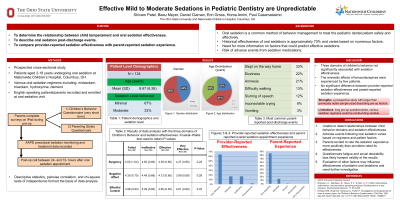Sedation
310 - Effective Mild to Moderate Sedations in Pediatric Dentistry are Unpredictable

.jpg)
Shivam Patel, DDS
Pediatric Dental Resident
The Ohio State University, Columbus, OH
The Ohio State University
Columbus, Ohio, United States- HA
Homa Amini, DDS
The Ohio State University
- PC
Paul Casamassimo, DDS
The Ohio State University
- DC
Daniel Claman, DDS
The Ohio State University
- Eg
Erin gross, DDS
The Ohio State University
- BM
Beau Meyer, DDS
The Ohio State University
- KH
Kim Hammersmith, DDS, MPH, MS
Program Director
The Ohio State University College of Dentistry, Columbus, OH and Nationwide Children's Hospital, Columbus, OH
Columbus, Ohio, United States
Presenting Author(s)
Co-Author(s)
Program Director(s)
Purpose: To evaluate the relationship between effectiveness of pediatric dental sedations using benzodiazepines with respect to perioperative factors such as child temperament, parenting style, and post-operative events.
Methods: This cross-sectional study enrolled children and parents at pediatric dental sedation visits. Inclusion was limited to English-speaking parents and children < 18 years old. The very short form Child Behavior Questionnaire (CBQ) and Parenting Styles Questionnaire (PSQ) were used. CBQ was scored over three domains: surgency, negative affect, and effortful control; and PSQ was categorized by the combined rank order of authoritative, authoritarian, or permissive parenting styles. The treating dentist rated the overall effectiveness. Parents completed an adverse events questionnaire 24-to-72 hours post-operatively via telephone. Descriptive statistics, pairwise correlation, and chi-square tests of independence formed the basis of analysis.
Results: Eighty-one children were included for analysis. The mean age was 8.7 years (SD: 3.4). CBQ domains surgency (P=0.22), negative affect (P=.29), and effortful control (P=.22) were not significantly associated with sedation effectiveness. Children of Authoritative-Permissive-Authoritarian parents were significantly more likely to have an effective sedation than children of Authoritative-Authoritarian-Permissive parents (P=.04). Dentist-reported sedation effectiveness was 81%. One-third of children slept on the way home, and one-in-five experienced post-operative amnesia for any aspect of the visit.
Discussion: The preliminary results from this ongoing study were unable to detect relationships between child temperament domains and sedation effectiveness. Children of parents with permissive, rather than authoritarian preferences, experienced more effective sedation. The amnestic effects of benzodiazepines were experienced by few patients.

.jpg)